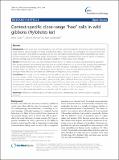Files in this item
Context-specific close-range "hoo" calls in wild gibbons (Hylobates lar)
Item metadata
| dc.contributor.author | Clarke, Esther | |
| dc.contributor.author | Reichard, Ulrich H. | |
| dc.contributor.author | Zuberbuehler, Klaus | |
| dc.date.accessioned | 2015-05-26T14:40:04Z | |
| dc.date.available | 2015-05-26T14:40:04Z | |
| dc.date.issued | 2015-04-08 | |
| dc.identifier | 190593917 | |
| dc.identifier | bc194aed-c592-4bcd-b35a-30464aeee3f8 | |
| dc.identifier | 000352257300001 | |
| dc.identifier | 84926652415 | |
| dc.identifier | 000352257300001 | |
| dc.identifier.citation | Clarke , E , Reichard , U H & Zuberbuehler , K 2015 , ' Context-specific close-range "hoo" calls in wild gibbons (Hylobates lar) ' , BMC Evolutionary Biology , vol. 15 , 56 . https://doi.org/10.1186/s12862-015-0332-2 | en |
| dc.identifier.issn | 1471-2148 | |
| dc.identifier.other | ORCID: /0000-0001-8378-088X/work/64360680 | |
| dc.identifier.uri | https://hdl.handle.net/10023/6695 | |
| dc.description | This work was supported by a Biotechnology and Biological Sciences Research Council PhD studentship awarded to EC. | en |
| dc.description.abstract | Background: Close range calls are produced by many animals during intra-specific interactions, such as during home range defence, playing, begging for food, and directing others. In this study, we investigated the most common close range vocalisation of lar gibbons (Hylobates lar), the 'hoo' call. Gibbons and siamangs (family Hylobatidae) are known for their conspicuous and elaborate songs, while quieter, close range vocalisations have received almost no empirical attention, perhaps due to the difficult observation conditions in their natural forest habitats. Results: We found that 'hoo' calls were emitted by both sexes in a variety of contexts, including feeding, separation from group members, encountering predators, interacting with neighbours, or as part of duet songs by the mated pair. Acoustic analyses revealed that 'hoo' calls varied in a number of spectral parameters as a function of the different contexts. Males' and females' 'hoo' calls showed similar variation in these context-specific parameter differences, although there were also consistent sex differences in frequency across contexts. Conclusions: Our study provides evidence that lar gibbons are able to generate significant, context-dependent acoustic variation within their main social call, which potentially allows recipients to make inferences about the external events experienced by the caller. Communicating about different events by producing subtle acoustic variation within some call types appears to be a general feature of primate communication, which can increase the expressive power of vocal signals within the constraints of limited vocal tract flexibility that is typical for all non-human primates. In this sense, this study is of direct relevance for the on-going debate about the nature and origins of vocally-based referential communication and the evolution of human speech. | |
| dc.format.extent | 11 | |
| dc.format.extent | 1096386 | |
| dc.language.iso | eng | |
| dc.relation.ispartof | BMC Evolutionary Biology | en |
| dc.rights | © 2015 Clarke et al.; licensee BioMed Central. This is an Open Access article distributed under the terms of the Creative Commons Attribution License (http://creativecommons.org/licenses/by/4.0), which permits unrestricted use, distribution, and reproduction in any medium, provided the original work is properly credited. The Creative Commons Public Domain Dedication waiver (http://creativecommons.org/publicdomain/zero/1.0/) applies to the data made available in this article, unless otherwise stated. | en |
| dc.subject | Referential communication | en |
| dc.subject | Primate vocalisations | en |
| dc.subject | Hylobatidae | en |
| dc.subject | Ape communication | en |
| dc.subject | Language evolution | en |
| dc.subject | Functionally referential signals | en |
| dc.subject | Food-associated calls | en |
| dc.subject | Primate alarm calls | en |
| dc.subject | Semantic communication | en |
| dc.subject | Playback experiments | en |
| dc.subject | Vocal communication | en |
| dc.subject | Acoustic features | en |
| dc.subject | BArbary macaques | en |
| dc.subject | Diana monkeys | en |
| dc.subject | Organization | en |
| dc.subject | QH301 Biology | en |
| dc.subject | QL Zoology | en |
| dc.subject | DAS | en |
| dc.subject.lcc | QH301 | en |
| dc.subject.lcc | QL | en |
| dc.title | Context-specific close-range "hoo" calls in wild gibbons (Hylobates lar) | en |
| dc.type | Journal article | en |
| dc.contributor.institution | University of St Andrews.School of Psychology and Neuroscience | en |
| dc.contributor.institution | University of St Andrews.Institute of Behavioural and Neural Sciences | en |
| dc.contributor.institution | University of St Andrews.Centre for Social Learning & Cognitive Evolution | en |
| dc.identifier.doi | 10.1186/s12862-015-0332-2 | |
| dc.description.status | Peer reviewed | en |
This item appears in the following Collection(s)
Items in the St Andrews Research Repository are protected by copyright, with all rights reserved, unless otherwise indicated.

